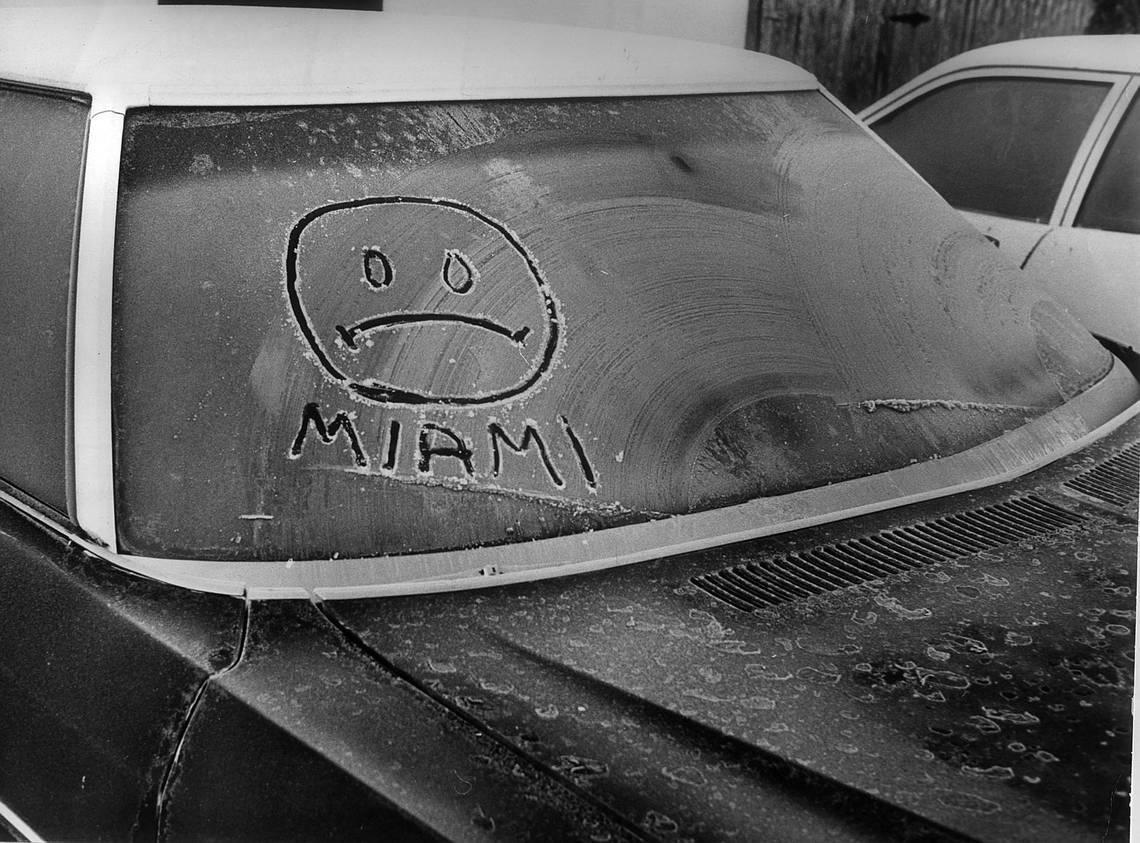It snowed in Miami? We woke up to the impossible on this day, and here’s what we did
Miami has shivered this winter.
Remember Christmastime cold, when temperatures dipped into the 30s and 40s and didn’t get warmer than the 50s? South Florida is facing a similar shot of cold this weekend.
But it won’t snow, forecasters say.
In January 1977, it did. The headlines blared, Snow in Miami!
Snow or not, are we ready to huddle around our smart TVs, wrapped in our FIU and UM hoodies and warming our frozen insides with churros and hot chocolate? Let’s look back through the Miami Herald archives and flip to Jan. 19, 1977: the day snow fell in the Magic City.
The day it snowed in Miami
Published Jan. 19, 2007 (marking 30 years at the time)
By Luisa Yanez
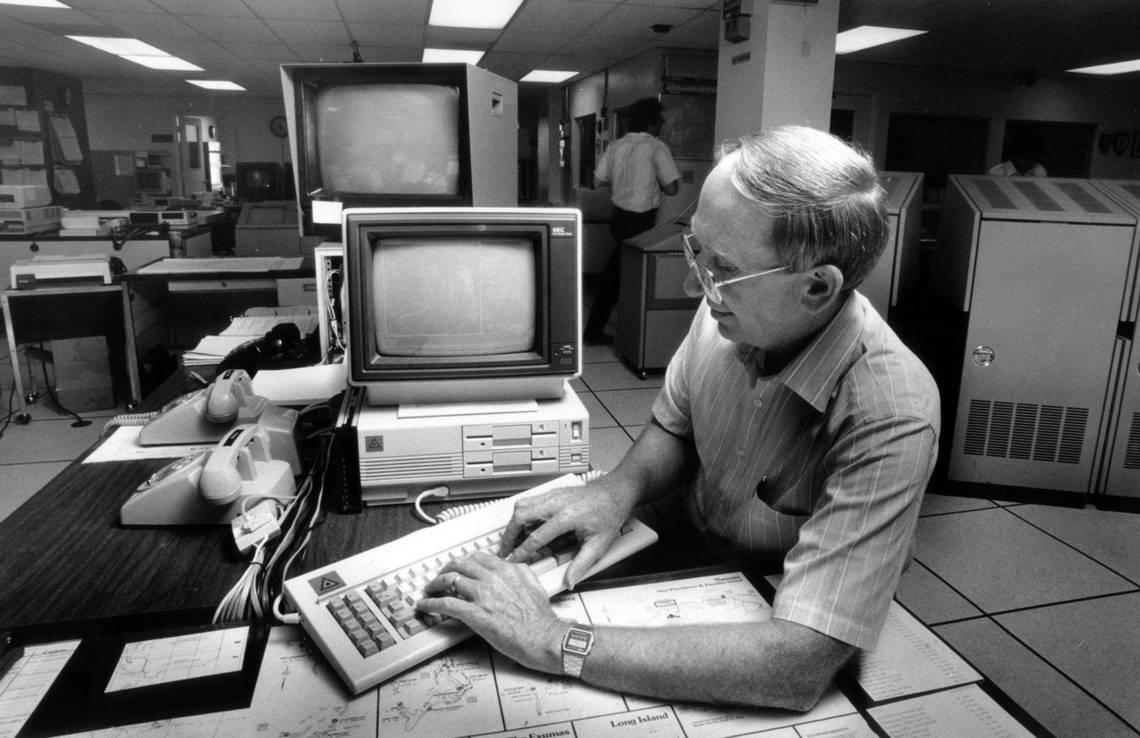
Miami weather forecaster Ray Biedinger looked at the screen of his trusty weather radar in the wee hours of Jan. 19, 1977, and dreaded what he had to do.
The bitter cold front barreling south across the state during his midnight shift at the old National Weather Service office, then in Coral Gables on South Dixie Highway, left him no choice but to issue one of Miami’s most unusual and historic forecasts:
“Cold with rain showers and the possibility of snow, ’’ Biedinger wrote. “If you notice, I didn’t put snow first in that forecast, ’’ Biedinger told the Herald in 2007.
But he got it right. Now, 45 years ago, snowflakes briefly dusted tropical palm trees, windshields, and people from Miami to Palm Beach — a freak and brief winter wonderland and the only South Florida snowfall on record in the 20th century.
Shivering South Floridians, young and old, looked to the sky in total amazement as tiny snowflakes landed on their faces. In those early-morning hours, snowflakes fell as far south as Homestead and daytime temperatures for the region dipped into the low 30s.
But by 9:30 a.m., South Florida’s big snow show was over, melted by the sun’s rays.
The headline on Miami’s afternoon newspaper, the Miami News, screamed in bold: Snow in Miami! The next day The Miami Herald’s read: The Day It Snowed in Miami.
The rare event remains a special memory for those who witnessed it.
Hurricanes come and go, but snow in Miami? That’s once in a lifetime.
Many South Floridians missed it - so there were skeptics. Veteran radio disc jockey Rick Shaw tried to set them straight from his radio booth.
He played Bing Crosby’s “White Christmas.” He said listeners who didn’t see or feel those fine granules were calling the station and asking why they were playing that song in the middle of January.
“Cause it’s snowing outside!” Shaw told them. “It was quite a day.”
Snow fell during an eventful week for South Florida - and the United States.
Newly-elected President Jimmy Carter’s inauguration was scheduled for the next day; and Dade County commissioners had passed the controversial ordinance banning discrimination against gays the day before, setting the stage for a bitter battle between singer Anita Bryant and gays.
The snow and the low temperatures put Florida’s citrus and vegetable industry in a death grip. Both were nearly wiped out, and about 150,000 migrant workers around the state lost their jobs - including 80,000 in Dade, Broward and Palm Beach counties.
Then-Gov. Reubin Askew declared a state of emergency. Officially, snow in Miami is not on the weather record books.
“It was an immeasurable amount that fell, so it’s written down as ‘a trace’ of snow, ’’ said Biedinger. Only once before, in 1899, had something resembling snow fallen over South Florida. And not this far south, only down to Fort Pierce.
Miami’s snowfall during the Blizzard of 1977 was caused by a combination of two arctic cold fronts - one passed the region on Jan. 16 followed by a second, faster-moving one in the middle of the night the day it snowed.
The precipitation formed in the clouds did not have enough time to melt before it reached the ground. If it had happened in the middle of the day, there probably would not have been snow, the weather service said.
But because of those few minutes of snow, history was made.
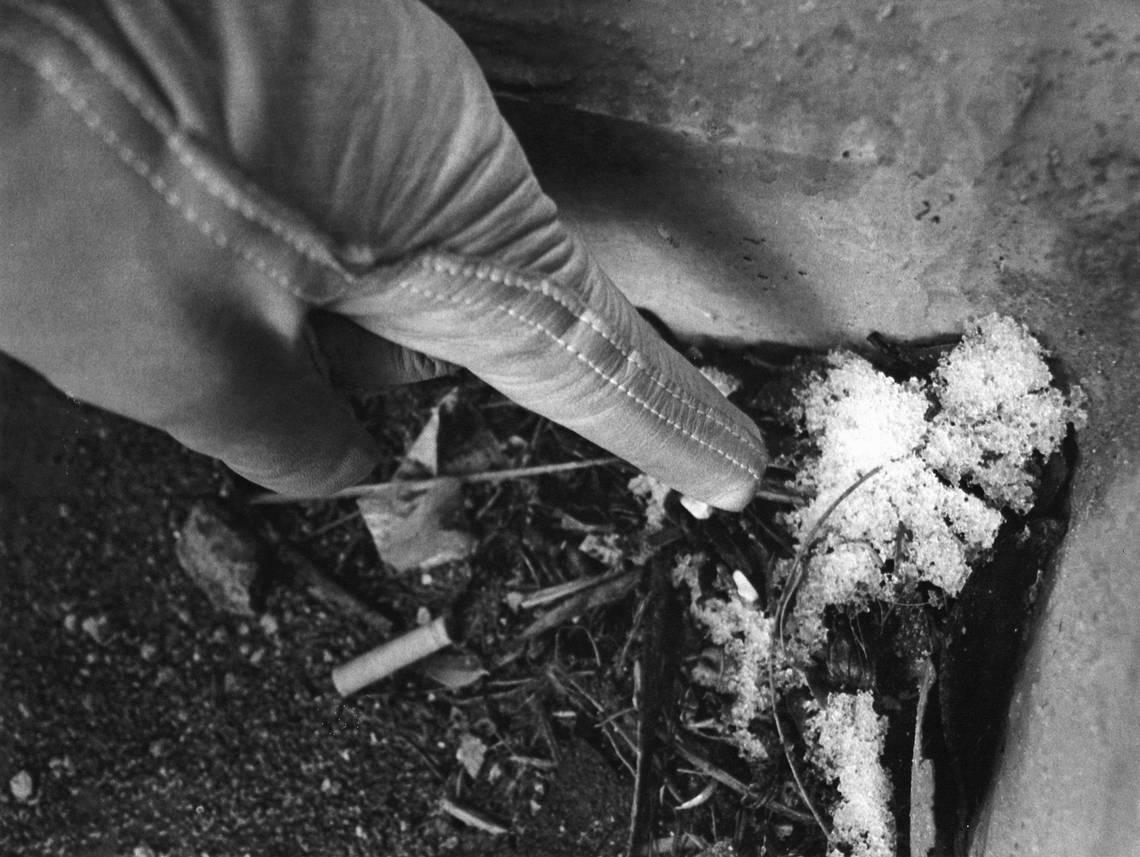
What we were doing the day it snowed
Published Jan. 20, 2007
By Michael Vasquez
Do you remember, too?
Dozens of Miami Herald readers — escorted on a chilly trip down memory lane by a Friday story chronicling the 30th anniversary of a morning when snow fell in Miami — responded by posting their own recollections on MiamiHerald.com.
Among the postings:
Frank Piloto Jr., who said he was working the day shift as a cop with the Miami-Dade Police Department on Jan. 19, 1977 -- the day of the only South Florida snowfall on record in the 20th century.
“I was at [Jackson Memorial Hospital] with the victim of a heart attack when I looked out the ER front doors and saw my partner, John Miller, struggling to walk across the parking lot toward the ER. John was from Indiana, I from Chicago. As we prepared to leave back on the road, we cleaned the windshield with our bare hands and threw the few flurries we could pick up at each other, our Miami version of a snow fight.”
It was by no means a blizzard — even calling it a dusting is an exaggeration. But in those early-morning hours, snowflakes fell as far south as Homestead and daytime temperatures for the region dipped into the low 30s. By 9:30 a.m., South Florida’s big snow show was over, melted by the sun.
There wasn’t enough snow to give birth to fat, round snowmen, or allow the dashing of sleds down a nearby hill. Weather record books give Miami credit for only a “trace” of snow that day. The word “magical” does not appear.
Except in the musings of those who were there.
“After 42 years in South Florida, I still talk about this day today,” Pat D’Angelo wrote at MiamiHerald.com. “I was a senior at Piper High School in Sunrise. I remember one girl crying and screaming. She couldn’t believe it!”
“It’s still probably the most unforgettable day I can remember in Miami,” posted a reader named George.
“I was 14 years old and an eighth-grader at North Miami Junior High. I recall my Mom driving me to school . . . listening to radio reports of snow falling in West Palm Beach and hoping, PRAYING it would make it to Miami.
“Well, sometime around the end of the first class the news spread like wildfire. It WAS snowing! The school emptied in a flash and we all stood outside amazed at the sight . . . for all the supposedly ‘gorgeous’ weather in Miami, it’s the day that it snowed that will ALWAYS retain a special place in my heart.”
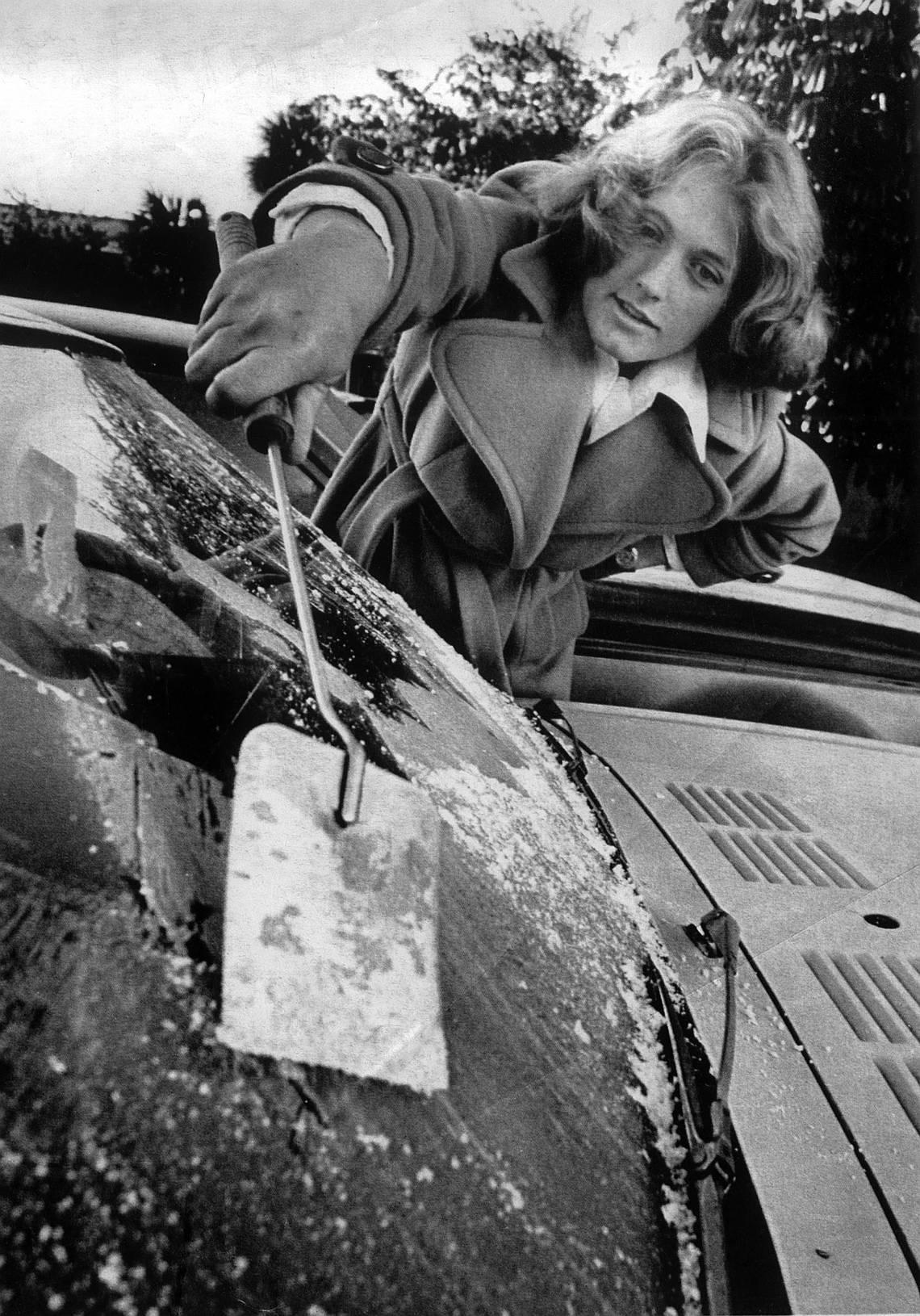
Of course, South Florida has always had its share of transplants from colder climes, some of whom were around in 1977 to witness Miami’s brief flirtation with the powdery stuff. To them, the question at the time was “What’s the big deal?”
“Originally from New Jersey, I had seen snow before, and wasn’t too impressed,” posted Rob G. “I mean, the snow was changing to rain as it was falling!”
“I was on winter break from UMass, and being from Boston could not understand what the big deal was,” wrote Mark Wolosz. “A [number of] years later (WOW) . . . now I know why! A great memory.”
And perhaps one with White House implications? Juan Paxety was living in Atlanta at the time, a city buzzing over the recent election of Georgian Jimmy Carter as president.
A day before the presidential election, a psychic appearing on a Georgia radio station had been asked to weigh in on Carter’s chances.
“The psychic’s answer — it will snow in Miami before Carter becomes president,” Paxety remembered.
“After Carter was elected, I just thought the psychic was wrong,” Paxety wrote. “Then came the morning of Carter’s inauguration. The radio reported the huge East Coast snowstorm -- including a report of snow in Miami. The psychic was right after all.”
Other out-of-towners drew their own conclusions as news of Miami’s sub-freezing temperatures traveled the nation.
“I live in New York,” wrote Diane Lapson. “I remember hearing it was snowing in Miami and thinking -- is this the end of the world?”
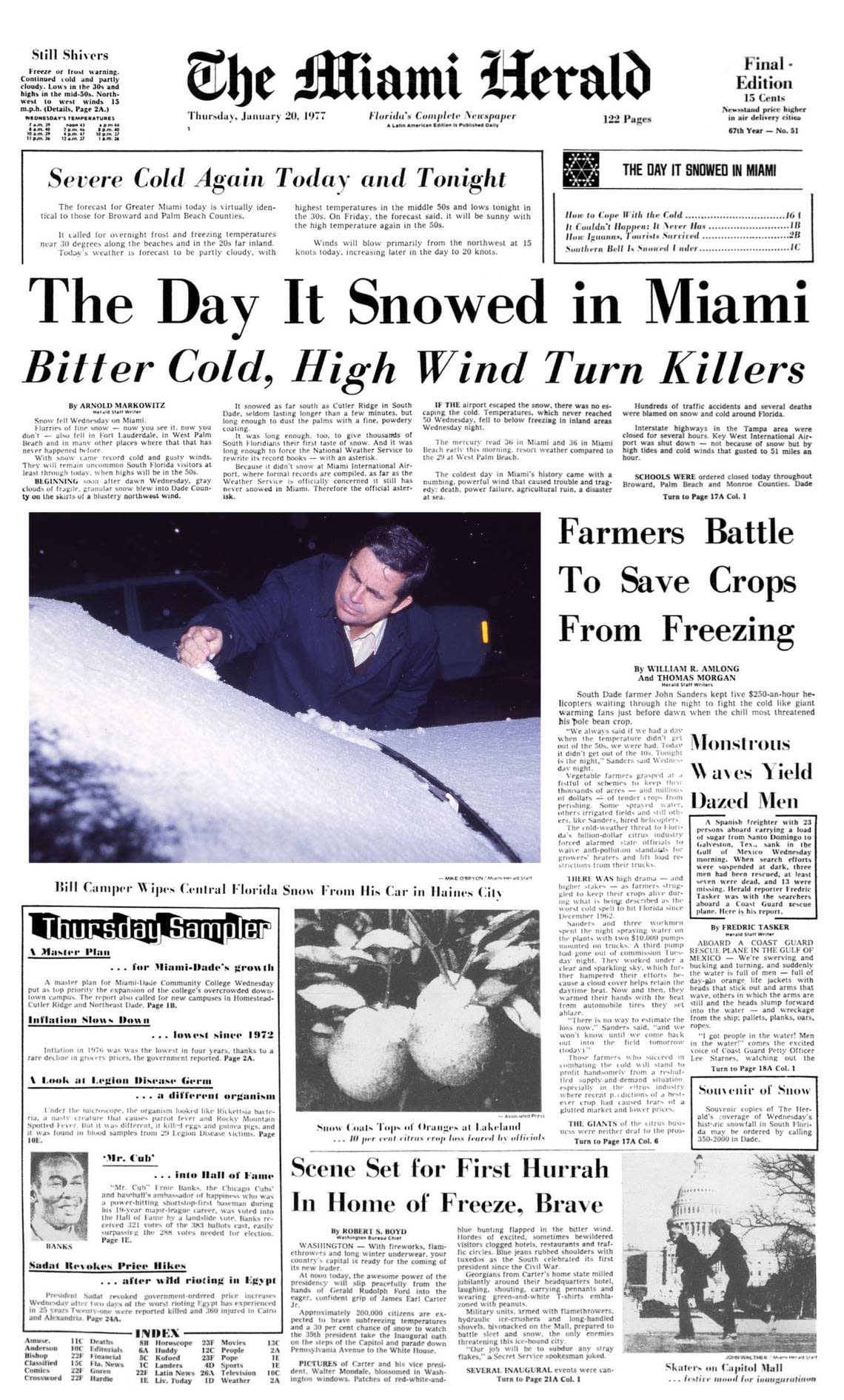
What Miami was like when it snowed in 1977
Published Aug. 26, 2007
By Paul George
Greater Miami in 1977 seems light years away from the city of today. Yet the trends that shaped and characterize 2007 Miami-Dade County, including development and population growth, were well underway 30 years ago.
Horse and farm country a couple of decades earlier, Kendall in 1977 was pushing west. Northwest Dade, also heavily agricultural until the recent past, was undergoing urbanization, too, with Miami Lakes, Carol City and Palm Springs leading the way.
Closer to the core, Brickell Avenue, one of the area’s most attractive residential streets, was on the cusp of great change, as developers began razing aging homes to make way for high-rise condominiums. By the end of the decade, the Palace, Atlantis and Imperial -- each designed by the innovative new firm Arquitectonica — were in the works. Developer Tibor Hollo, who believed in the future of the decaying area north of downtown, opened the heralded Omni Shopping Mall, complete with a 21-story hotel. Farther north along Biscayne Boulevard, Florida International University, Miami’s new state university, opened a second campus in North Miami.
Proponents of downtown, which was ailing from a dwindling residential base and the flight of businesses and professionals to suburbia, hoped Metrorail, still at that time in the planning stages, would bring more people to the old quarter. Bicentennial Park, which opened on the site of the earlier Port of Miami in January 1977, disappointed its champions, as visitors failed to materialize. Historic preservation, a new mindset, was in the air in run-down South Beach where Barbara Capitman and the newly formed Miami Design Preservation League started a movement to save the area’s Art Deco buildings.
Meanwhile, the rapid “Latinization” of Miami, which would ultimately transform it into an international city, moved forward. By 1977, about 500,000 Hispanics lived in Greater Miami, more than 85 percent of whom were Cubans. Depicted in the media as an exotic venue, Little Havana was already a popular destination for visitors. Many visitors would come in subsequent years to the Calle Ocho Open House, created in 1977, and later known as the Calle Ocho festival.
Many companies conducting business in the Caribbean and Latin America had established headquarters in the South Florida area as a result of the rising influence of Hispanics — though the political empowerment of Cuban Americans was still several years away. Instead, Greater Miami’s power brokers remained, however tenuously, white males who spoke with a slight Southern accent, and, as often as not, pronounced their hometown “Mi-am-uh.”
After civil rights legislation was passed, the area’s long-repressed black population recorded impressive gains. The dynamic Dr. Johnny Jones was appointed superintendent of the county’s large public school system in 1977. Father Theodore Gibson, the area’s preeminent civil rights leader, held a seat on the Miami City Commission. The Black Archives, History and Research Foundation of South Florida opened in Liberty City in the new Joseph Caleb Center.
Since its early days, the history of Greater Miami has been marked by controversy and filled with flamboyant characters; 1977 was no different.
The day before snow fell in Miami for the only recorded time in its history, the County Commission passed an ordinance banning discrimination against gays, setting the stage for a bitter battle with conservative forces led by singer and Miami Beach resident Anita Bryant, who succeeded in forcing the overturning of the law.
That and other controversies appeared quaint in the years immediately following 1977, when Greater Miami was racked by the cocaine wars, racial rioting and the chaotic influx of more than 125,000 Cubans in a six-month period during the Mariel Boatlift.
Paul S. George, a professor at Miami Dade College.
